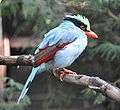Magpie
| Magpies | |
|---|---|
 | |
| Eurasian magpie | |
| Scientific classification | |
| Kingdom: | Animalia |
| Phylum: | Chordata |
| Class: | Aves |
| Order: | Passeriformes |
| Family: | Corvidae |
| Genera | |

Magpies are birds of the Corvidae (crow) family, including the black and white Eurasian magpie, which is considered one of the most intelligent animals in the world, and the only non-mammal species able to recognize itself in a mirror test[1] (though a recent study suggests that giant manta rays can also recognize their own reflection[2]). In addition to other members of the genus Pica, corvids considered as magpies are in the genera Cissa.
Systematics and species
According to some studies, magpies do not form the monophyletic group they are traditionally believed to be—a long tail has certainly elongated (or shortened) independently in multiple lineages of corvid birds.[3] Among the traditional magpies, there appear to be two distinct lineages. One consists of Holarctic species with black/white colouration and is probably closely related to crows and Eurasian jays. The other contains several species from South to East Asia with vivid colouration which is predominantly green or blue. The azure-winged magpie and the Iberian magpie, formerly thought to constitute a single species with a most peculiar distribution, have been shown be two distinct species and classified as the genus Cyanopica.[4]
Other research has cast doubt on the taxonomy of the Pica magpies, since it appears that P. hudsonia and P. nuttalli may not be different species, whereas the Korean race of P. pica is genetically very distinct from the other Eurasian (as well as the North American) forms. Either the North American, Korean, and remaining Eurasian forms are accepted as three or four separate species, or there exists only a single species, Pica pica.[5]
Holarctic (black-and-white) magpies
- Genus Pica
- Eurasian magpie, Pica pica
- Black-billed magpie, Pica hudsonia (may be conspecific with P. pica)
- Yellow-billed magpie, Pica nuttalli (may be conspecific with P. (pica) hudsonia)
- Korean magpie, Pica sericea (may be conspecific with P. pica)
Oriental (blue/green) magpies
- Genus Urocissa
- Taiwan blue magpie Urocissa caerulea
- Red-billed blue magpie, Urocissa erythrorhyncha
- Yellow-billed blue magpie, Urocissa flavirostris
- White-winged magpie, Urocissa whiteheadi
- Sri Lanka blue magpie, Urocissa ornata
- Genus Cissa
- Common green magpie, Cissa chinensis
- Indochinese green magpie, Cissa hypoleuca
- Javan green magpie, Cissa thalassina
- Bornean green magpie, Cissa jefferyi
Azure-winged magpies
- Genus Cyanopica
- Azure-winged magpie, Cyanopica cyanus
- Iberian magpie, Cyanopica cooki
Other "magpies"
- The black magpie, Platysmurus leucopterus, is a treepie; it is neither a magpie nor, as was long believed, a jay. Treepies are a distinct group of corvids externally similar to magpies.
- The Australian magpie, Cracticus tibicen, is conspicuously piebald, with black and white plumage reminiscent of a European magpie. It is a member of the family Cracticidae and not a corvid.
In culture
- The Magpie's Nest
- The Weaver Girl and the Cowherd, Chinese folk tale where a flock of magpies form a bridge to reunite the lovers for one day.
- "Heckle and Jeckle", a cartoon about magpies who were always getting into trouble, shown in the United States in the 1960s.
- One for Sorrow (nursery rhyme)
- La Gazza Ladra (The Thieving Magpie) an opera by Rossini and also The Thieving Magpie a live album by the prog rock band Marillion, so named because the band used Rossini's overture as the opening music for their concerts.
Gallery
References
- ↑ Prior H, et al. (2008). De Waal F, ed. "Mirror-Induced Behavior in the Magpie (Pica pica): Evidence of Self-Recognition". PLoS Biology. Public Library of Science. 6 (8): e202. doi:10.1371/journal.pbio.0060202. PMC 2517622
 . PMID 18715117. Retrieved 2008-08-21.
. PMID 18715117. Retrieved 2008-08-21. - ↑ Ari, C.; D’Agostino, D.P. (2016). "Contingency checking and self-directed behaviors in giant manta rays: Do elasmobranchs have self-awareness?". Journal of Ethology. Springer. 34 (2): 167–174. doi:10.1007/s10164-016-0462-z.
- ↑ Ericson et al. (2005)
- ↑ Kyukov et al, Synchronic east–west divergence in azure-winged magpies (Cyanopica cyanus) and magpies (Pica pica), Journal of Zoological Systematics and Evolutionary Research 42(4): 342-351 (2004)
- ↑ Lee et al., 2003
Bibliography
- Anonymous (2006): The Word Origin Calendar: Sat./Sun. March, 11–12, 2006. Accord Publishing.
- Ericson, Per G. P.; Jansén, Anna-Lee; Johansson, Ulf S. & Ekman, Jan (2005): Inter-generic relationships of the crows, jays, magpies and allied groups (Aves: Corvidae) based on nucleotide sequence data. Journal of Avian Biology 36: 222–234.
- Lee, Sang-im; Parr, Cynthia S.; Hwang, Youna; Mindell, David P. & Choe, Jae C. (2003): Phylogeny of magpies (genus Pica) inferred from mtDNA data. Molecular Phylogenetics and Evolution 29: 250–257.
External links
- Magpie videos, photos and sounds on the Internet Bird Collection



